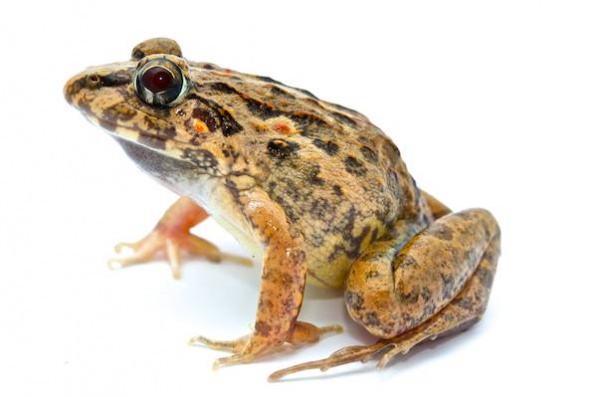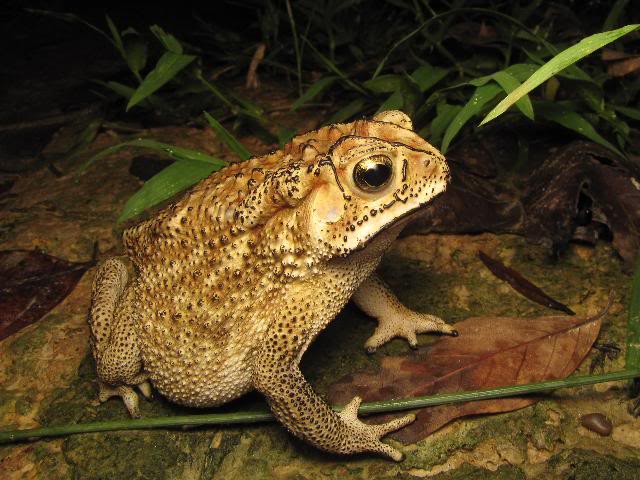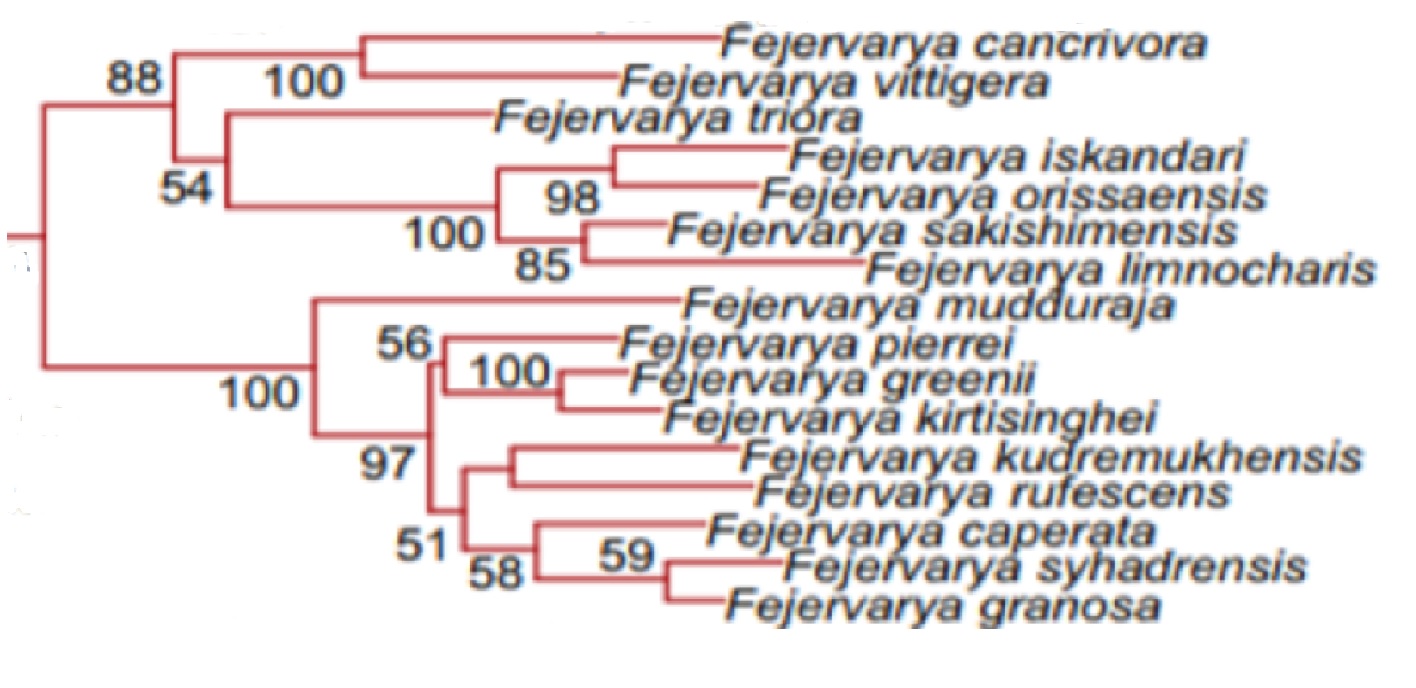Crab-Eating Frog

Table of Contents
Figure 1. Specimen from Potowangka, western Flores, Indonesia. From http://www.ecologyasia.com/verts/amphibians/crab-eating_frog.htm (Accessed on 27 Oct 2017)
| While its name suggests its dietary preference, in fact, it could eat anything it can fit into its mouth. |
1. Identification
| The easiest way to identify the Crab-eating frog is not by sight, but by hearing its "machine gun" calls. |
1.1 Diagnosis
 |
| F. cancrivora |
 |
| F. limnocharis |
Photo from
http://www.frogsofborneo.org/dicroglossidae/165-dicroglossidae/fejervarya/limnocharis/139-fejervaryalimnocharis#g_1_0 (Accessed on 2 Nov 2017)
F. cancrivora can be distinguished from F. limnocharis by having a deeper head and a more pointed beak-like snout [3]. But can you really tell the difference?
1.2 Comparison with other species in same habitat

 |
| Related image |
 |
| Kaloula pulchra |
 |
| F. limnocharis |
From left to right; Crab-eating frog, Asian common toad, Malayan banded bullfrog, Rice field frog.
To identify a frog at night (they are nocturnal) can be tricky. However, it is possible to narrow down the candidates of the unknown species to a few, and all it is left to do is to hear its mating call.
For mating call comparison, refer to section 2.1 Calls.
1.3 Coloration
Color varies from brown, or greenish-brown, to gray, with irregular darker bars scattered on the lips and hindlimbs. The venter is whitish, sometimes with scattered darker markings [3].



Photos from http://www.ecologyasia.com/verts/amphibians/crab-eating_frog.htm (Accessed on 1 Nov 2017)
1.4 Variation
Males have vocal sacs [2]. Mature males may or may not have dark throats and thumbs, and sometimes lack slits opening to the vocal sac [3].1.5 Tadpole Morphology
Tadpoles have a maximum total length of 40 mm. The body is oval-shaped and dark-colored with dark spots. The tail is less than twice the body length. The spiracle is centered on one side of the body. The mouth is situated under the snout. The upper lip has a single row of papillae and the lower lip has two rows [3] . (Unfortunately, an image of its tadpoles are not available. Do feel free to contribute one! Email to a0125203@u.nus.edu)2. Biology
| Frogs and toads of different species call at different frequencies and rhythms, filling up the soundscape while preventing overlapping of sound waves. |
2.1 Calls - Machine Gun
The mating calls of F. cancrivora sound like fast throat gargles [3], and can be easily distinguishable from other anurans living in the same habitat.In Singapore, you would be expected to find 4 to 5 other Anurans in places that you would find the crab-eating frog. Below are the sounds of some of these anurans. The first sound you hear is the crab-eating frog, but do play all the sound files at the same time to test yourself if you can still identify the calls of the crab-eating frog amongst all the others.
Comparison of common anuran calls

Crab-eating frog
 |
| Related image |
Asian common toad
Photo from https://whyevolutionistrue.wordpress.com/2011/06/30/frogs/duttaphrynus_melanostictus_tarakan003/ (Accessed on 29 Oct 2017)
 |
| Kaloula pulchra |
Malayan banded bullfrog
Photo from https://www.thainationalparks.com/species/banded-bull-frog (Accessed on 29 Oct 2017)
 |
| F. limnocharis |
Rice Field frog
2.2 Breeding Habits - All year long
F. cancrivora breeds all year-round, but most active at the beginning of the wet season [3].2.3 Feeding Habits - They eat anything they can find and fit into their mouth!
Fejervarya cancrivora is a very opportunistic species that will feed on Crustaceae when insects are scarce. The diet of F. cancrivora inhabiting brackish water is predominantly crustacean, while the diet of those in freshwater is mainly insects and some small vertebrates such as frogs. It is also suggested that the only choice-limiting factor is prey size [1].2.4 Salt Tolerance - Best of the Frogs
While there are other species (Xenopus laevis and Bufo viridis) that can withstand salinity (20 and 26 ppt of salinity respectively), only F. cancrivora can tolerate saline waters constantly. The average salinity of seawater is 35 ppt. It is able to adapt from freshwater to seawater within a few hours [4]. Adults and tadpoles can live in saltwater with salinity up to 2.8% and 3.9% respectively. [5]It can regulate water gain/loss through its skin such that the rate is maintained constant at any osmolarity. This is credited to its ability to raise the osmolar concentration of its plasma greater than that of the external environment [6].
In other words, you can't find a better frog at tolerating salt waters.
2.5 Reduced Cutaneous Water Loss - Lowest of them all
The area-specific evaporative water loss rate from cutaneous skin in F. cancrivora is the lowest known for frogs. It is suggested that cutaneous resistance has evolved as a way for it to reduce water loss while on land, in order to offset high osmotic losses to seawater before frogs fully acclimate to the high salinity of seawater [7].3. Habitat & Distribution
3.1 Habitat
F. cancrivora are found in both fresh water and brackish water. For brackish water habitats, they can usually be found on the banks of meanders [8] and edges of tidal prawn ponds [9]. Fresh water habitats, on the other hand, includes flooded rice fields [10], ponds, swamps and ditches [11].In Singapore, Feyervarya cancrivora can be commonly found in mangroves, forests, and even parks. In other words, they can be found anywhere.
3.2 Native DistributionIn Singapore, F. cancrivora can be found in both fresh and brackish water swamps and ditches, though it is usually collected near slow-moving or stagnant fresh water [1]. It is also usually found in mangrove swamps [7].
Specimen in mangrove habitat at Pulau Ubin, Singapore. Available from: http://www.ecologyasia.com/verts/amphibians/crab-eating_frog.htm (Accessed on 2 Nov 2017) 3.3 Global Distribution Map adapted from http://maps.iucnredlist.org/map.html?id=58269 (Accessed on 29 Oct 2017) F. cancrivora was first reported from Java, and other reports have come from India, Sri Lanka, Indonesia, the Gulf of Thailand and land areas bordering the South China Sea [1]. It is widely distributed in Southeast Asia, including Brunei, India, Indochina (Cambodia, Laos, Malaysia, Thailand, Vietnam), coastal southern China (Hainan and Guangxi), Philippines, Sulawesi, Nusa Tenggara, and Irian Jaya [4] [12]. It has also been introduced to Guam [13] and to Papua New Guinea [12]. 4. Habitat Loss4.1 Environmental degradationA study in the Malang District in Java, Indonesia found that the Fejervarya cancrivora among the 4 out of 7 species of frogs that went extinct after 17 years. This was attributed to the extensive construction works occurring in the researched areas [14].Moreover, the establishment of oil palm plantations have led to drastic species loss across Southeast Asian countries. Anuran counts for oil palm plantation was below optimum even for disturbed habitat specialist species which increased in diversity and abundance once oil palm had been removed [15]. In Singapore, urbanization coupled with deforestation continues to narrow their habitat areas. The fact that we could find these anurans in our parks and gardens shows us how we have driven them to live with us and anurans often find it more difficult to look for mates as their mating calls would be mixed into the soundscape of our heavy traffic. Nevertheless, this emphasizes on the importance of "green connectivity" as a means to retain biodiversity in our concrete landscape. 5. Conservation Status |
According to The IUCN Red List of Threatened Species, F. cancrivora is listed as Least Concern due to its wide distribution, tolerance of a broad range of habitats, presumed large population, and it is unlikely to decline to qualify for listing in a more threatened category [16].
Nevertheless, over-harvesting, habitat loss, wood harvesting from mangroves, urbanisation processes may still threaten F. cancrivora populations [12]. Up to 75% of Indonesia's export of frog legs for food consumption are from F. cancrivora [17].
Although F. cancrivora is not a particular species of concern, it is good to note that amphibians are a vulnerable group, where about 1 out of 3 species are endangered on the Red List.
6. Taxonomy
6.1 Description
The original description by Gravenhorst (1829) based on lost samples could not be traced back. A neotype from Java, Indonesia is used as a replacement.The species is described from a neotype by Dubois and Ohler (2000). [2]
"Fejervarya cancrivora has a SVL (snout to vent length) of 68.2 mm. The sides of the head have small glandular warts. Parts of the flanks have glandular folds and the lower part has glandular warts. The back has interrupted dorsolateral folds. The dorsal sides of the limbs have warts and folds, while the ventral surfaces are smooth. It has a medium sized, narrow head. The snout is oval. Fejervarya cancrivora has a rounded canthus rostralis, a concave loreal region, and a flat interorbital space. The nostrils, which are closer to the tip of the snout than the eye, are oval and have a small flap. The tympanum is distinct. The pupil is rounded. It has a few teeth between the choanae on the vomerine ridge. The tongue is large. It has a supratympanic fold. No parotoid glands are present. The fingers are long and the finger tips are pointed. Some of the fingers have dermal fringes, but have no webbing. Subarticular tubercles are present and are rounded. Toes are long and have webbing and dermal fringes." (Dubois & Ohler, 2000).
 |
| External features of frog |
Figure available from http://www.kshitij-pmt.com/Biology/Structural-organisation-in-animals/frogs.aspx
6.2 History of Fejervarya
Fejervarya is one of the Asian genera of frogs in the Dicroglossidae family. First proposed in 1915, the genus did not see widespread adoption at first. In the 1990s, it was generally included as the subgenus of Rana and later placed as subgenus as Limnonectes. It was first treated as an independent genus in 1998.6.3 English Common Names
Fejervarya cancrivora goes by many common names, but in Singapore, it is commonly known as the crab-eating frog.List of english common names:
Crab-eating Frog
Asian Brackish Frog
Rice Field Frog
Mangrove Frog
Javan Wart Frog
Java Wart Frog
Marsh Frog
Brackish Water Frog
Pattani Wart Frog
Gulf Coast Frog
6.4 Classification
Synonyms:Rana cancrivora: Gravenhorst, 1829
Rana tigrina var. angustopalmata: Van Kampen, 1907
Rana tigerina angustopalmata:Barbour, 1912
Rana tigerina var. cancrivora: Boulenger, 1918
Rana cancrivora: Annandale, 1918
Rana (Rana) cancrivora: Boulenger, 1920
Rana cancrivora canrivora: Dunn, 1928
Rana cancrivora raja: Smith, 1930
Dicroglossus cancrivorus: Deckert, 1938
Rana raja: Taylor, 1962
Rana (Euphylctis) cancrivora: Dubois, 1981
Euphylctis cancrivora: Poynton and Broadley, 1985
Limnonectes (Hoplobatrachus) cancrivous: Dubois, 1987
Limnonectes (Hoplobatrachus) raja: Dubois, 1987
Limnonectes (Fejervarya) raja: Dubois, 1992
Limnonectes (Fejervarya) cancrivorus: Dubois, 1992
Feyervarya raja: Iskandar, 1998; Dubois and Ohler, 2000; Fei, Ye, Jiang, and Xie, 2002
Fejervarya cancrivora: Iskandar, 1998; Fei, 1999; Dubois and Ohler, 2000; Fei, Ye, Jiang, and Xie, 2002
Integrated Taxonomic Information System (ITIS)
7. Phylogeny
The genera Fejervarya consists of 16 described species, and some putative but undescribed ones [18].
In a paper by Pyron and Wiens, large-scale maximum likelihood estimate of amphibian phylogeny, containing 2871 species represented by up to 12,871 bp of sequence data from 12 genes (3 mitochondrial, 9 nuclear genes) is conducted. The maximum likelihood tree is based on rapid-bootstrapping analysis. Numbers at nodes at based on bootstrap value over 50%.
There are 4 species with unknown and/or missing holotypes, and are placed incertae sedis in Fejervarya. They are namely; F. altilabris, F. brama, F. assimilis, and F. frithii.
Fejervarya cancrivora is located at the top right of the figure. There are strong support for the branching of F. cancrivora and its sister taxon F. vittigera at 100% bootstrap value. In the genus alone, F. cancrivora and its sister taxon F. vittigera has one of the highest node stability, and thus can be said with more certainty that they are indeed 2 different species.
8. References
[1] Elliott, A. B., & Karunakaran, L. (1974). Diet of Rana cancrivora in fresh water and brackish water environments. Journal of Zoology, 174(2), 203-215.
[2] Dubois, A. and Ohler, A. (2000). ''Systematics of Fejervarya limnocharis (Gravenhorst, 1829) (Amphibia, Anura, Ranidae) and related species. 1. Nomenclatural status and type-specimens of the nominal species Rana limnocharis Gravenhorst, 1829.'' Alytes, 18(1-2), 15-50.
[3] McKay, J.L. (2006). A Field Guide to the Amphibians and Reptiles of Bali. Krieger Publishing Company, Malabar, Florida.
[4] Ren, Z., Zhu, B., Ma, E., Wen, J., Tu, T., Cao, Y., Hasegawa, M., and Zhong, Y. (2009). ''Complete nucleotide sequence and gene arrangement of the mitochondrial genome of the crab-eating frog Fejervarya cancrivora and evolutionary implications .'' Gene, 441, 148-155.
[5] Gordon, M. S., Schmidt-Nielsen, K., & Kelly, H. M. (1961). Osmotic regulation in the crab-eating frog (Rana cancrivora). Journal of Experimental Biology, 38(3), 659-678.
[6] Dicker, S.E. and Elliott, A.B. (1970). ''Water uptake by the Crab-eating Frog Rana Cancrivora, as affected by osmotic gradients and by neurohypophysial hormones.'' Journal of Physiology, 207, 119-132.
[7] Wygoda, M. L., Dabruzzi, T. F., & Bennett, W. A. (2011). Cutaneous resistance to evaporative water loss in the crab-eating frog (Fejervarya cancrivora). Journal of Herpetology, 45(4), 417-420.
[8] Bullock, J. A. (1966). Observations on the fauna of Pulau Tioman and Pulau Tulai. 7. The food of the amphibians and reptiles. Bull. natn. Mus. St. Singapore, 34, 85-96.
[9] Chew, M. M. (1972). A study of the permeability of gastro-intestinal tissues of the euryhaline frog Rana cancrivora. M.Sc. Thesis, Nanyang University, Singapore.
[10] Church, G. (1960). The effects of seasonal and lunar changes on the breeding pattern of the edible Javanese frog, Rana cancrivora Gravenhorst. Treubia. 25, 215-233.
[11] Alcala, A. C. (1962) Breeding behaviour and early development of frogs of Negros, Philippine Islands. Copeia 1962. 679-726
[12] Zhigang, Y., Zhao, E., Haitao, S., Diesmos, A., Alcala, A., Brown, R., Afuang, L., Gee, G., Sukumaran, J., Yaakob, N., Ming, L. T., Chuaynkern, Y., Thirakhupt, K., Das, I., Iskandar, D., Mumpuni, and Inger, R. (2009). Fejervarya cancrivora. In: IUCN 2011. IUCN Red List of Threatened Species. Version 2011.2. www.iucnredlist.org. Downloaded on 11 November 2011.
[13] Christy, M. T., Clark, C. S., Gee II, D. E., Vice, D., Vice, D. S., Warner, M. P., Tyrrell, C. L., Rodda, G. H. and Savidge, J. A. (2007). ''Recent records of alien anurans on the Pacific Island of Guam.'' Pacific Science, 61(4), 469-483.
[14] Wulandari, D. R., Habibi, M., & Listyorini, D. (2013). Observation of Frog Species in State University of Malang as a Preliminary Effort on Frog Conservation. Journal of Tropical Life Science, 3(1), 43-47.
[15] Barnett, J. B., Benbow, R. L., Ismail, A. H. M. A. D., & Fellowes, M. D. (2013). Abundance and diversity of anurans in a regenerating former oil palm plantation in Selangor, Peninsular Malaysia. Herpetological Bulletin, 125, 1-9.
[16] Zhigang, Y., Ermi, Z., Haitao, S., Diesmos, A., Alcala, A., Brown, R., Afuang, L., Gee, G., Sukumaran, J., Yaakob, N., Tzi Ming, L., Chuaynkern, Y.,Thirakhupt, K., Das, I., Iskandar, D., Mumpuni & Inger, R.. 2004. Fejervarya cancrivora. The IUCN Red List of Threatened Species 2004: e.T58269A11759436. Available on http://dx.doi.org/10.2305/IUCN.UK.2004.RLTS.T58269A11759436.en. Downloaded on 19 October 2017.
[17] Kusrini, M.D., and Alford, R.A. (2006). ''Indonesia’s exports of frogs’ legs.'' TRAFFIC Bull, 21, 13-24.
[18] Pyron, R. A., & Wiens, J. J. (2011). A large-scale phylogeny of Amphibia including over 2800 species, and a revised classification of extant frogs, salamanders, and caecilians. Molecular Phylogenetics and Evolution, 61(2), 543-583.
Links to other types of species pages
American Museum of Natural History
Amphibia Web
Ecology Asia
Frogs of Borneo

